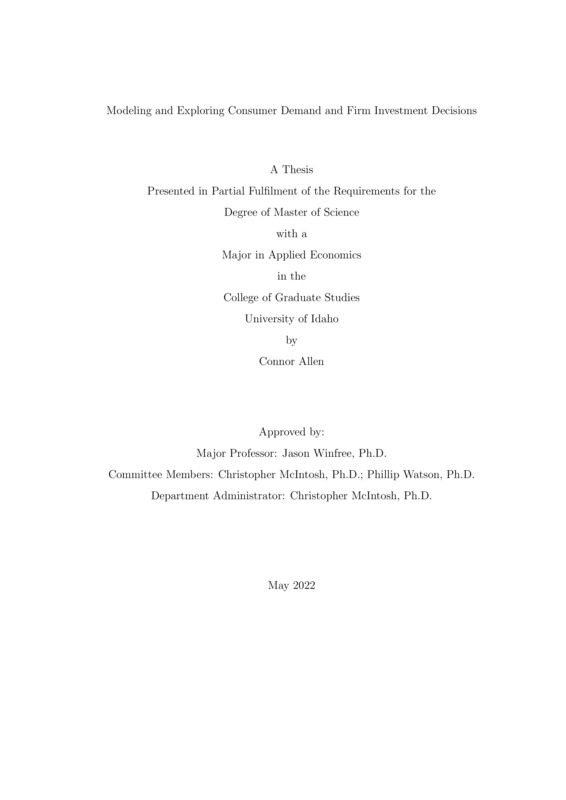Modeling and Exploring Consumer Demand and Firms Investment Decisions
Allen, Connor Lee. (2022-05). Modeling and Exploring Consumer Demand and Firms Investment Decisions. Theses and Dissertations Collection, University of Idaho Library Digital Collections. https://www.lib.uidaho.edu/digital/etd/items/allen_idaho_0089n_12379.html
- Title:
- Modeling and Exploring Consumer Demand and Firms Investment Decisions
- Author:
- Allen, Connor Lee
- Date:
- 2022-05
- Keywords:
- Competition Consumer Demand Contest Success Functions Firm Investment Regression Analysis Theoretical Economics
- Program:
- Agricultural Economics & Rural Soc
- Subject Category:
- Agriculture economics; Economic theory; Economics
- Abstract:
-
The focus of this thesis is on modeling and exploring both firm investment decisions and consumer demand. The research presented analyzing three unique cases, two in which firm investment is the focus and take a theoretical approach to modeling firm investment decisions and a third case that empirically models and evaluates consumer demand. Firm investment is estimated in the cases of League Profit and Market sizes, with a focus in evaluating how teams choose the optimal market for league expansion and relocation then in the setting of a hypothetical food court in which vendors either compete or collude with on another and the investment choices made to optimize both the court and vendor returns. Consumer demand is investigated through modeling the market for different vodka types sold in the state of Idaho, presenting the unique structure of each market independently and analyzing how consumers of a given vodka chose to compliment and/or substitute their consumption of their choice alcohol with the alternatives available to them. Beginning with our exploration on league market size and profitability; it is often assumed that sports leagues should have teams in the largest markets. However, our model shows that, depending on talent investment's role in team revenue, this is not necessarily true. Heterogeneity in markets sizes can not only decrease costs, but can also increase expected league revenue. Having a smaller market leads to an expectation that the large market team will win and creates less competition for playing talent. This creates a situation where leagues may prefer expansion teams to be in smaller markets or they want teams to relocate to smaller markets. Although there could be caveats, such as changes in consumer demand due to a decrease in competitive balance, greater market size differences can lead to higher league profits under general conditions.
Moving forward our paper next evaluates firm investment in the unique case of food courts. Employing our model to examines food courts, where vendors are competing with each other for a fixed number of consumers. This case may arise when consumers are traveling and patronize a food court, or if the destination is a food court. A contest success function is used to describe consumers' choices, as well as vendor investment and profitability. Using a contest success function allows for varying degrees of substitution between the vendors. Substitution can be a function of location or product space. The model analyzes revenue sharing and changes in product differentiation when aggregate demand for the food court is fixed. The model is also examined if the food court has a collective reputation that depends upon the average investments of each vendor.
Switching gears, this paper next examines consumer demand; through the market for vodka in the State of Idaho, exploring consumer demand for and consumer consumption of vodka. Using data provided by the state of Idaho, vodka is classified into one of five distinct types, from here a model is developed and employed to explain the demand for vodka. Own price, price of substitutes (wine, beer, other vodka types, and all other liquor), consumer income, unemployment, and population are all employed in the regression. Month, year, location of the sale (Store ID number) and months in which Covid was a factor are also controlled for. This research provides some evidence that each individually classified vodka is a unique separate market from the summation of all vodkas as one market, and further, all alcohols as one market. With each specific type of vodka having its own unique demand and consumption behavior to be analyzed and modeled independently.
- Description:
- masters, M.S., Agricultural Economics & Rural Soc -- University of Idaho - College of Graduate Studies, 2022-05
- Major Professor:
- Winfree, Jason
- Committee:
- McIntosh, Christopher; Watson, Philip
- Defense Date:
- 2022-05
- Identifier:
- Allen_idaho_0089N_12379
- Type:
- Text
- Format Original:
- Format:
- application/pdf
- Rights:
- In Copyright - Educational Use Permitted. For more information, please contact University of Idaho Library Special Collections and Archives Department at libspec@uidaho.edu.
- Standardized Rights:
- http://rightsstatements.org/vocab/InC-EDU/1.0/

